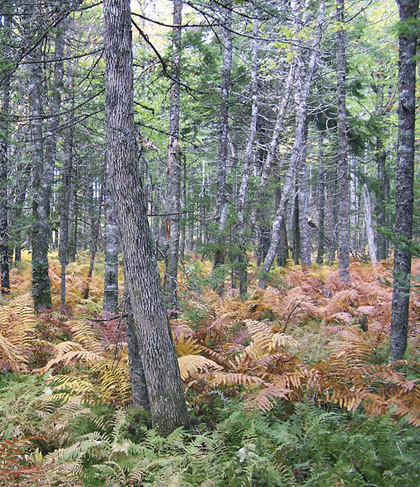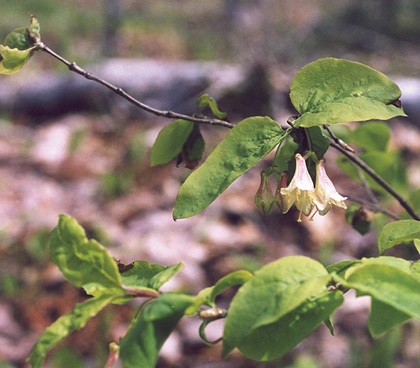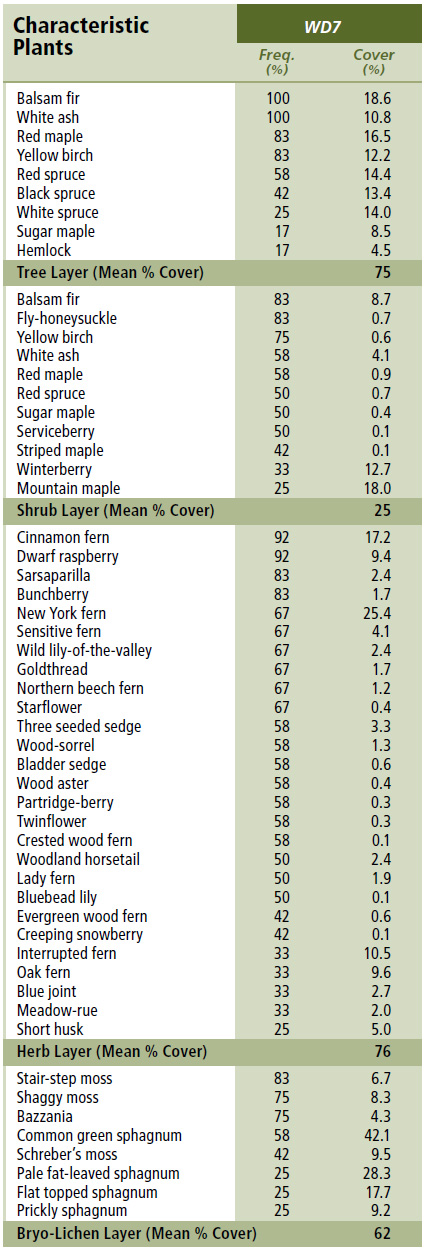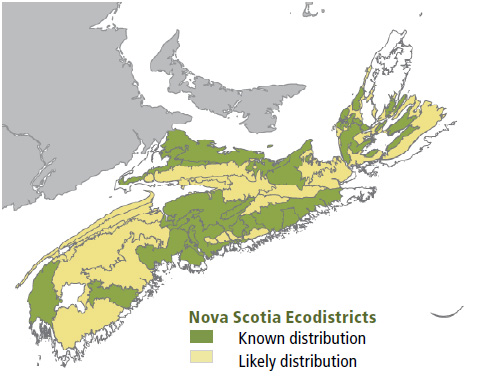
Forest Vegetation types - WD7
WD7 — Balsam fir – White ash / Cinnamon fern – New York fern /Sphagnum
Abies balsamea – Fraxinus americana /Osmunda cinnamomea – Thelypteris noveboracensis / Sphagnum spp.
 |
Sherbrooke Lake, Lunenburg County |
Concept: Balsam fir – White ash / Cinnamon fern – New York fern / Sphagnum Vegetation Type (VT) is the wettest and richest of the three wet mixedwood forests (WD6, WD7 and WD8) found in the province. This closed canopy forest occurs on wet mineral soils or peat, with intermediate or high nutrient availability. The unit is co-dominated by white ash and one or more coniferous tree species. Balsam fir is particularly prominent, but most stands also feature low levels of spruce and yellow birch. The understory is largely dominated by herbaceous and sphagnum cover.
Vegetation: The closed canopy is co-dominated by white ash and balsam fir, with lesser spruce (usually red) and yellow birch. Low to moderate cover is typical in the woody understory, where regenerating trees and fly-honeysuckle are characteristic. The well-developed herbaceous layer includes frequent cinnamon fern, dwarf raspberry, sensitive fern and New York fern, among other species. Bryophyte development is moderate, composed of sphagnum, shaggy moss and lesser amounts of common upland species. Common green sphagnum is prominent.
Environmental Setting: This moderately exposed wet forest is invariably found on level sites with slight microtopography and little exposed bedrock or surface stones. Soils have intermediate to high nutrient availability, largely maintained by enriched seepage, ground and/or surface water inputs. It occurs at low elevation across level to undulating landscapes on organic deposits or fine to medium textured mineral soils. Most stands are in upland regions of mainland Nova Scotia and across lower elevations of Cape Breton. The WD7 ecosystem has not been documented in New Brunswick or Prince Edward Island, but it likely occurs in southern New Brunswick.
Successional Dynamics: This ecosystem can be expressed at a variety of successional stages, but most stands are mid-successional, persisting as an edaphic climax. It is maintained by limiting site conditions and small- to intermediate-scaled disturbances. Tree senescence, windthrow and smaller scaled timber harvest events are the primary mechanisms of renewal. WD7 does not generally shift to other vegetation types after disturbance, but a transition to WD1 (White ash / Sensitive fern – Christmas fern) is possible on higher fertility sites. Excluding harvesting, stand-level disturbance events are rare but insect infestation may cause a significant reduction of balsam fir in some stands.
Ecological Features: Rich temperate mixedwood forests are uncommon in Nova Scotia, partly because nutrient demanding conifer species (e.g. cedar) are seldom present. By virtue of its rarity and restricted Canadian range, lesser disturbed examples of this unusual ecosystem present a conservation opportunity. WD7 may support a mix of wet coniferous and deciduous forest values, including important wildlife habitat structures, hydrologic and biogeochemical functions. Few species of conservation concern were found in available plot data. Similar to other wetlands, WD7 contributes to carbon and nitrogen budgets, helps regulate groundwater quality and flow, and represents an important component of landscape structure.
 |
| Fly-honeysuckle |
Distinguishing Features: White ash is diagnostic of this wet mixedwood forest. Fly-honeysuckle is characteristic along with a well developed herbaceous layer that often includes cinnamon fern, dwarf raspberry, sensitive fern and New York fern.
| Slope Position: | Level7 Depression1 Lower1 Toe1 |
Surface Stoniness: |
(Non - Slightly)9 (Moderately)1 |
Bedrock Outcrop: |
(Non-rocky)10 |
Elevation Range: |
50 - 189m |
Slope Gradient: |
Level10 |
Aspect: |
East1 South1 West1 None7 |
Exposure: |
Moderate7 Mod. exposed2 Mod. sheltered1 |
Microtopography: |
Slightly5 Level3 nd2 |
Drainage: |
Poor5 Very poor5 |
Soil Type: |
ST146 ST41 ST71 ST101 ST131 |
Parent Material: |
Organic4 Glacial till3 Alluvium1 Glaciofluvial1 Lacustrine1 |
Rooting Depth (cm): |
(<30)6 (30-45)3 nd1 |
Duff Thickness (cm): |
(6-10)3 (11-20)1 (21-40)2 (>40)3 nd1 |

